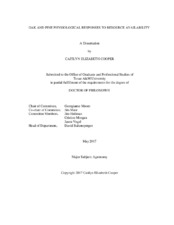| dc.description.abstract | Large-scale drought and fire events result in extensive mortality and shifts in species’ ranges. More research on responses to resource limitations is needed to predict species’ success following record disturbance events and in the face of predicted increases in weather-related extremes. Therefore, the effects of resource availability were evaluated on 1) gas exchange and carbon allocation of three oak (Quercus) species in a controlled precipitation restriction experiment in College Station, TX, USA, and 2) loblolly pine (Pinus taeda L.) and oak recovery following the 2011 Bastrop County Complex Fire (BCCF), Bastrop, TX, USA.
Bur (Quercus macrocarpa Michx.; QUMA), Shumard (Q. shumardii Buckley; QUSH), and live oak (Q. virginiana Mill.; QUVI) saplings were subjected to two watering treatments: 1) watered, which received the equivalent of average weekly precipitation and 2) droughted, in which precipitation was reduced by 100%. Watered saplings displayed greater height increases, leaf water potential, and gas exchange rates than droughted saplings. Species differed in gas exchange rates and carbon allocation patterns. Live oak was the most drought tolerant, exhibiting 57% greater photosynthesis rates than QUSH and QUVI. Physiological changes associated with senescence and winter preparation affected foliar carbohydrate and phenolic content to a greater extent than water availability.
Following the BCCF, differences in vegetation anatomy, physiology, and age were found to affect stand recovery and resource use. Regenerating pines were shorter and less dense in severely burned than moderately burned plots. Gas exchange and pressure-volume results suggested loblolly pine seedlings preferred drought-avoidance strategies while resprouting oaks exhibited greater drought tolerance. Mature pines had greater sap flux rates (Js) than oaks, but resprouting oaks had greater Js on average than the regenerating pines due to declines in pine seedling Js with reductions in shallow soil moisture. Transpiration was greatest at the moderately burned stand (2.08 mm day^-1 ), intermediate at the unburned stand (1.48 mm day^-1 ), and least for the severely burned stand (0.46 mm day^-1 ). Results suggest light to moderate burns may enhance stand transpiration through competition release and increased irradiance, while severe fires reduce stand transpiration through reductions in vegetation density in the first five years after fire. | en |


